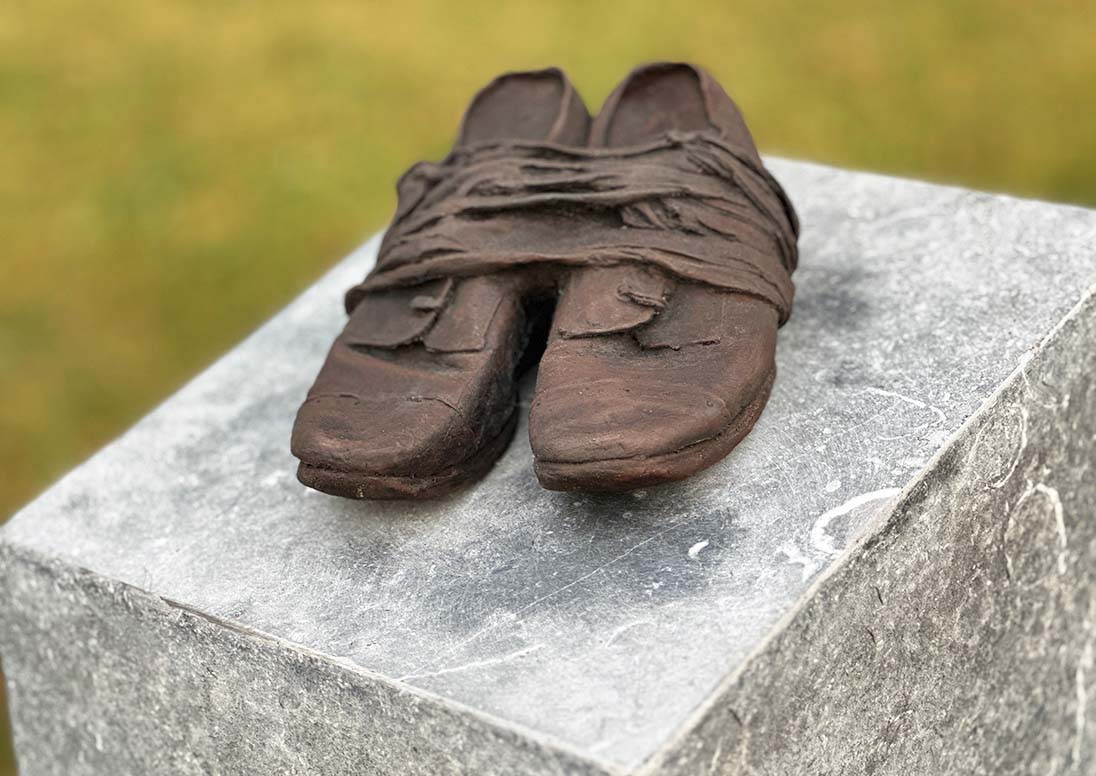
City unveils Irish Global Famine Way project

The City of St. Catharines is proud to unveil the Irish Global Famine Way project, a monument of iconic Bronze Shoes accompanied by an interpretative panel, commemorating the thousands of Irish immigrants and Famine survivors who arrived in St. Catharines between 1837 and 1850 to work on the Second Welland Canal.
Niagara Irish Festival championed and funded the project, supported by the St. Catharines Heritage Advisory Committee, with technical and administrative assistance from the St. Catharines Arts and Culture Advisory Committee, Cultural Services, Planning Services, and Historical Services, City of St. Catharines. Trinity Construction Management donated, carved, and installed the stone on the grounds of the St. Catharines Museum and Welland Canals Centre.
Many of the Irish Famine emigrants arrived destitute and starving. The labourers lived with their families alongside the canal worksite in shanties as the Board of Works struggled to find enough work to employ them all. Living conditions pushed some labourers to riots and violence, which was eventually policed by the military.
Within a generation, their descendants became foundational members of our community. Many in our city can trace their lineage back to the labourers we honour with these bronze shoes.
“Our Irish Global Famine Way installation is a symbol of the spirit of determination and resilience of the Irish Famine emigrants, who in the face of great loss and hardship, sought hope across the sea and built new lives in our city as community builders,” Kathleen Powell, City Supervisor of Historical Services and Curator, said of the installation, unveiled July 8 at the museum during a celebration which featured Niagara Irish Festival musicians performing traditional Irish songs.
At its peak, more than 5,000 Irish labourers arrived on the Welland Canal projects in the 1840s, outnumbering the local population of 3,500.
“This monument honours the memory and celebrates the contributions and the legacy of our city’s Irish immigrants and their families,” Powell continued. “We are humbled to be a key location in Canada on the Irish Global Famine Way.”
The Irish Global Famine Way extends from the National Famine Way in Ireland to follow the journeys of Irish Famine emigrants to the United Kingdom, Canada, the United States, South Africa, and Australia; each key location is marked by the iconic Bronze Shoes and accompanying information about the Irish Famine emigrants.
The Museum, located at 1932 Welland Canals Pkwy., was chosen as host for the Niagara monument since the history of the Irish Famine emigrants is central to the story of our community and the Welland Canals, stories they share every day.
Ireland’s Great Famine, which followed consecutive years of potato blight that decimated potato crops on which Ireland’s people relied, could have been “either completely or largely mitigated” had the resources of the United Kingdom been brought to bear, Ireland’s Great Hunger Museum states on its website.
“Within Ireland itself there were substantial resources of food that, had the political will existed, could have been diverted, even as a short-term measure, to feed the starving people,” the Great Hunger Museum stated. “The policy of closing ports during periods of shortages in order to keep homegrown food for domestic consumption had on earlier occasions proved to be effective in staving off famine within Ireland. By refusing to allow this policy to be adopted in 1846-47, the British government ensured that Black ’47 was indelibly associated with suffering, famine, mortality, emigration, and to some, misrule.”
As such, the Great Irish Famine was a defining moment in Irish history. Its effect permanently impacted the island’s demographic, political and cultural landscape.
The National Famine Way in Ireland is a 165-kilometre-long trail that begins at the National Famine Museum, cared for by the Irish Heritage Trust. The trail traces the footsteps of 1,490 tenants from Strokestown, Roscommon to Dublin in 1847 during the Great Irish Famine. It was their last journey on Irish soil and for the two-thirds of them who survived travel abroad by ship, their first steps on their journey to new lives in North America as part of the Irish diaspora.
